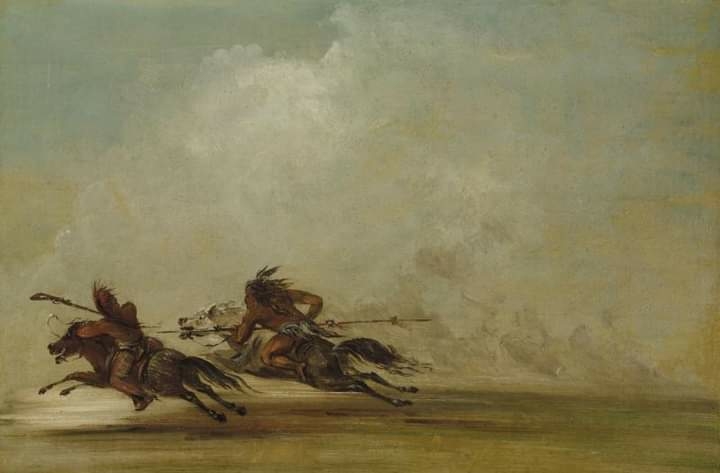-
Posts
115,419 -
Joined
-
Last visited
-
Days Won
586
Content Type
Profiles
Forums
Events
Everything posted by RETIREDFAN1
-
-
The photo you see has been floating around different Texas history pages and many of them are wondering what was on this man's mind at the time it was taken? The photo was taken by a photographer from Life Magazine in 1937. The town is Freer, Texas in Duvall County. The history of Freer is quite extensive, but for us at All Things Texas we believe that we can give a little more context to this photo. The single most important event in the history of Freer occurred in 1928. Three wildcatters drilling on the W. P. Norton property just southwest of what is now the Freer townsite struck one of the nation's largest oil reserves. The discovery of oil soon turned Freer into what Life magazine called "the last of the tough frontier oil towns." Those who had seen Freer grow into a town they called home soon realized that the oil boom was changing their way of life and not for the good to those who lived there. The onset of the "Great Depression" soon saw a little bit of normalcy come to the town of Freer. But, the 1930s were a decade of phenomenal growth in Freer. The town had two businesses in 1931, but by the spring of 1933, when a fire that started in the Bluebonnet Cafe on Main Street came close to destroying the town. The fire merely provided the citizens of Freer with an opportunity to display their resilience. By 1936, when the community's population was estimated at 1,200, Freer had sixty businesses and was incorporated for a time. Two years later both the population and the number of businesses had doubled. The town quickly attracted a colorful cast of prostitutes, gamblers, drifters, and drunks, and a certain type of boomtown trash one could say. So, we believe that this is a photo of an older gentleman just making sure that things on the streets of Freer, Texas remains calm. Today the population of Freer, Texas is around 2,400.
-
When it became clear the Titanic was going down, Isidor and Ida Straus did as requested—the couple put on life jackets and moved to the Boat Deck where officers were lowering lifeboats and instructing women, children, and First Class passengers to board. According to detailed accounts from Ida's maid and Isidor's work colleague (both surviving eyewitnesses who recounted the story to newspapers at the time) a Third Officer told Ida, who was wearing a full-length mink coat to brave the icy outdoor temperatures, to step onto the lifeboat. She did. When the officer beckoned to Isidor, prompting him to follow, he shook his head. Isidor said, “No I will not get on the lifeboat until I see that every woman and child has a chance to escape.” The officer recognizing Mr. Straus as the co-owner of Macy’s, offered him a place on the lifeboat 8 but he declined electing to remain on the deck. According to Archibald Gracie in "The Truth About the Titanic", at first the men tried to get Mrs. Straus into the boat but she would not go without her husband. Then the men all agreed that an old gentleman like Isador should be allowed into the boat. Gracie writes: "'No', he said, 'I do not wish any distinction in my favor which is not granted to the others.' As near as I can recall them these were the words which they addressed to me. Seeing this, Ida then climbed back out of the boat and turned to her beloved husband. "We have lived a wonderful life together for 40 years and have six beautiful children together, if you won't get on the life boat, I won't either,” she told him. She removed her mink coat and handed it her maid, Ellen Bird. "I won't have any further need," she said. "Please take this as you get into a lifeboat to keep you warm, until you are rescued." Other sources say Ida stated, "We have lived together for many years. Where you go, I go." Archibald Gracie writes, 'They expressed themselves as fully prepared to die, and calmly sat down in steamer chairs on the glass-enclosed Deck A, prepared to meet their fate.' Isidor wrapped his arms around her, then, a great wave came over the port side of the ship and swept them both into the sea. Isidor's body (No. 96) was recovered by the MacKay-Bennett and taken to Halifax. Ida was lost to the sea. (February 6th, 1849–April 15th, 1912) Born on the same day, they died on the same day.
-
Spit never killed anyone.......
-
-
Ok....the Colmes Files are going back to the greatness that they were founded on.......the history posts I put there will stay because it's too hard to move them here.....lol.....all new history posts, though, will go here.......
-
Because they're the only ones in the region who don't want us dead......
-
Sha'arayim was a border city between Philistia and Judah during the reign of David in 11th century BCE. In 2008, a broken piece of pottery was found during an excavation of Khirbet Qeiyafa, which many connect to the biblical city called Sha’arayim (mentioned in Joshua 15:36; 1 Samuel 17:52; and 1 Chronicles 4:31). The pottery’s text may roughly agree with 1 Samuel 8, where Samuel describes what will happen to the people when the nation becomes a monarchy, mainly that the population will be oppressed by those in power. Read all about it and scholars' disagreements over its language, date, and even the direction of the letters! Copy/paste this link or search up, "Qeiyafa Ostracon relates the birth of the Kingdom of Israel" on Biblical Archaeology Society. https://www.biblicalarchaeology.org/daily/biblical-artifacts/inscriptions/the-qeiyafa-ostracon-relates-the-birth-of-the-kingdom-of-israel/
-

TRUMP 2024: PUTTING AMERICA AND AMERICANS FIRST
RETIREDFAN1 replied to RETIREDFAN1's topic in Political Arena
-

PIZZAGATE....... Pedophiles in high places
RETIREDFAN1 replied to RETIREDFAN1's topic in Political Arena
-
-
As depicted in ‘The Expanse’ TV show, is there any practical benefit to having guns incorporated into the gauntlets of power armour rather than having power-armoured soldiers carry conventional small-arms? Not really. It’s a sci-fi gimmick. It’s only there to show “we’re so advanced that we don’t need “normal” guns anymore”. There are plenty of issues with it: You need a safety mechanism to prevent it from firing when your fingers got in the way. And if that breaks… You can’t use our normal bullets because the barrel length is so limited (less than the length from your wrist to your elbow). The accuracy would be drastically affected unless you have something like the gyrojet (which is more expensive than normal bullets because it’s a mini rocket). Aiming is impossible if your electronic sight/HUD is broken or ran out of power. Normal guns have iron sights as backup. How do you absorb the recoil with that? You’re not resting it against your shoulders, so you need some advanced recoil dampening or stabilization mechanism to keep it aimed even when it’s firing on full auto. Jams are going to be significantly more difficult to deal with because you only have your non-dominant hand to work with until you can get the whole assembly off. Given that it doesn’t seem to have magazines, the ammo must be stored somewhere in the armor and is fed through some kind of an internal belt. If something is wrong with that belt, it looks like you quite literally have to strip down to access the problematic component. I don’t know about you but it will take me at least a minute from wearing that armor to taking off enough parts for me to start working with the system. Now, do that when you’re under enemy fire. I don’t know if that’s even possible if you’re in space since the inner suit doesn’t seem to be life-supporting. I really can’t think of any advantage, which is why this has never been considered in the hundreds of years since we have had firearms. EDIT: I just thought of another fatal weakness: Rule #1 of gun safety: Never point a gun at anything other than what you intend to shoot and always treat the gun as if it’s loaded. Having a gun locked to your arm means you sacrificed the use of your dominant hand. Combat medics obviously can’t use it. Even normal troops would have issues because you can accidentally sweep your entire squad and innocent people with it when you’re just trying to do something harmless. It doesn’t matter what kind of safety the gun has or whether or not it’s loaded. This is a fundamental rule everyone should know before touching a gun. And for those who say “you can fix this with that technology”, then the question is: Is the end product better than just plain old handheld rifle? I really can’t think of any advantage with this setup even with super advanced technology that never fails. Even “you will never lose the gun this way” is questionable since the gun unit must be detachable and therefore is liable to be left behind. There’s a reason why we very rarely see gauntlet (war) weapons even in the medieval era when they were a bit “creative”. A sword, pike, or bow is so much better. At most, it’d be a concealable weapon for assassins. Same thing goes with those who say, “if this is the logic, why would they bother making the F-35?” Because the F-35 offers many things that previous airplanes don’t. This setup only offers trouble with no real advantage even when it works fine.
-
-
-
-
The Comanches were the fiercest, and the most feared, of the Great Plains tribes. Their way of life was characterized by raiding to obtain horses and slaves, a lifestyle that kept them in a constant state of warfare against not only white settlers, but all neighboring tribes as well. The Comanche domain extended through what is now Texas, Oklahoma, Kansas, Colorado, and New Mexico. Never numbering more than 20,000, and usually numbering fewer than 10,000, the Comanches had separated from the Shoshoni tribe after acquiring horses in the late 1600s. They soon became among the most skilled horseback warriors in history. Comanche raiders would strike suddenly and unexpectedly, their war cries and warpaint striking fear into the hearts of their victims. Although they sometimes fought with pistols or shotguns (rifles were too difficult to fire accurately while riding), Comanches preferred lances and arrows. Skilled Comanche warriors could rapidly and accurately fire arrows at an enemy while hanging below their horses’ necks. Lying flat atop galloping horses, Comanches were difficult to hit in battle, even while able to hit their enemies seemingly with ease. Seeking out horses, the Comanches would raid any targets of opportunity. Along with horses, Comanches would carry away women and children as prizes, but any men they captured were almost always killed on the spot. Comanche wars against Spanish, Mexican, Texan, and American authorities (as well as against all neighboring tribes) began in the early 1700’s and continued through the mid to late 1870’s. The last of the Comanches finally surrendered and were relocated to a reservation in 1875. The images that most continue have of western Indians (dress, culture, horsemanship, bravery, ferocity) derive primarily from the Comanches. Fourteen Comanche “code talkers” participated in the D-Day invasion—a story that deserves and shall have a post of its own. Today there about 15,000 Comanches living on tribal lands in Oklahoma. The flag of the Comanche nation proudly bears the title given to them by those who feared them for centuries: “The Lords of the Southern Plains.” The image is George Catlin’s painting “Comanche Warrior Lancing an Osage, at Full Speed” (1837), which is in the Smithsonian American Art Museum.




















